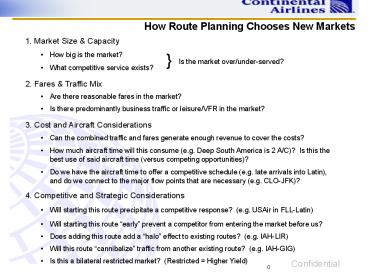No name PowerPoint PPT Presentation
Title: No name
1
How Route Planning Chooses New Markets
1. Market Size Capacity
- How big is the market?
Is the market over/under-served?
- What competitive service exists?
2. Fares Traffic Mix
- Are there reasonable fares in the market?
- Is there predominantly business traffic or
leisure/VFR in the market?
3. Cost and Aircraft Considerations
- Can the combined traffic and fares generate
enough revenue to cover the costs?
- How much aircraft time will this consume (e.g.
Deep South America is 2 A/C)? Is this the best
use of said aircraft time (versus competing
opportunities)?
- Do we have the aircraft time to offer a
competitive schedule (e.g. late arrivals into
Latin), and do we connect to the major flow
points that are necessary (e.g. CLO-JFK)?
4. Competitive and Strategic Considerations
- Will starting this route precipitate a
competitive response? (e.g. USAir in FLL-Latin)
- Will starting this route early prevent a
competitor from entering the market before us?
- Does adding this route add a halo effect to
existing routes? (e.g. IAH-LIR)
- Will this route cannibalize traffic from
another existing route? (e.g. IAH-GIG)
- Is this a bilateral restricted market?
(Restricted Higher Yield)
2
How Route Planning Chooses New Markets
3
How Route Planning Chooses New Markets
- Alliances Built Around Your Needs
- The Sky Team Alliance
- Aeroflot Russian Airlines
- AeroMéxico
- Air France
- Alitalia
- China Southern
- Continental Airlines
- Czech Airlines
- Delta Air Lines
- KLM Royal Dutch Airlines
- Korean Air
- Northwest Airlines
- Associate Members
- Air Europa
- Copa Airlines
- Kenya Airways
4
How Route Planning Chooses New Markets
Our On-Going Mission Growth
92 growth in 10 years!
107
55
5
How Route Planning Chooses New Markets
- ASM GROWTH AT WARP SPEED
From 12,952,514,174 ASM to 20,812,715,918 in 5
years!
PowerShow.com is a leading presentation sharing website. It has millions of presentations already uploaded and available with 1,000s more being uploaded by its users every day. Whatever your area of interest, here you’ll be able to find and view presentations you’ll love and possibly download. And, best of all, it is completely free and easy to use.
You might even have a presentation you’d like to share with others. If so, just upload it to PowerShow.com. We’ll convert it to an HTML5 slideshow that includes all the media types you’ve already added: audio, video, music, pictures, animations and transition effects. Then you can share it with your target audience as well as PowerShow.com’s millions of monthly visitors. And, again, it’s all free.
About the Developers
PowerShow.com is brought to you by CrystalGraphics, the award-winning developer and market-leading publisher of rich-media enhancement products for presentations. Our product offerings include millions of PowerPoint templates, diagrams, animated 3D characters and more.

